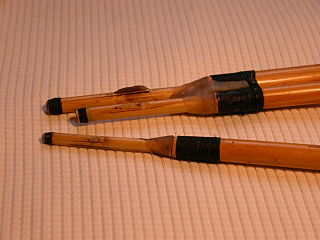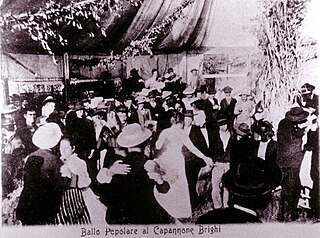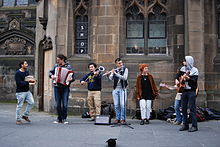
In Spain, music has a long history. It has played an important role in the development of Western music, and has greatly influenced Latin American music. Spanish music is often associated with traditional styles such as flamenco and classical guitar. While these forms of music are common, there are many different traditional musical and dance styles across the regions. For example, music from the north-west regions is heavily reliant on bagpipes, the jota is widespread in the centre and north of the country, and flamenco originated in the south. Spanish music played a notable part in the early developments of western classical music, from the 15th through the early 17th century. The breadth of musical innovation can be seen in composers like Tomás Luis de Victoria, styles like the zarzuela of Spanish opera, the ballet of Manuel de Falla, and the classical guitar music of Francisco Tárrega. Nowadays commercial pop music dominates.
Tarantella is a group of various southern Italian folk dances originating in the regions of Calabria, Campania and Puglia. It is characterized by a fast upbeat tempo, usually in 6
8 time, accompanied by tambourines. It is among the most recognized forms of traditional southern Italian music. The specific dance-name varies with every region, for instance Sonu a ballu in Calabria, tammurriata in Campania, and pizzica in Salento. Tarantella is popular in Southern Italy, Greece, Malta, and Argentina. The term may appear as tarantello in a linguistically masculine construction.

Zampogna is a generic term for a number of Italian double chantered bagpipes that can be found as far north as the southern part of the Marche, throughout areas in Abruzzo, Latium, Molise, Basilicata, Campania, Calabria, Apulia and Sicily. The tradition is now mostly associated with Christmas, and the most famous Italian carol, "Tu scendi dalle stelle" is derived from traditional zampogna music. However, there is an ongoing resurgence of the instrument in secular use seen with the increasing number of folk music festivals and folk music ensembles.

In Italy, music has traditionally been one of the cultural markers of Italian national and ethnic identity and holds an important position in society and in politics. Italian music innovation – in musical scale, harmony, notation, and theatre – enabled the development of opera, in the late 16th century, and much of modern European classical music – such as the symphony and concerto – ranges across a broad spectrum of opera and instrumental classical music and popular music drawn from both native and imported sources.

Southern Italy, also known as Meridione or Mezzogiorno, is a macroregion of Italy consisting of its southern regions.

The launeddas are a traditional Sardinian woodwind instrument made of three pipes, each of which has an idioglot single reed. They are a polyphonic instrument, with one of the pipes functioning as a drone and the other two playing the melody in thirds and sixths.

Griko, sometimes spelled Grico, is the dialect of Italiot Greek spoken by Griko people in Salento, and also called Grecanico, in Calabria. Some Greek linguists consider it to be a Modern Greek dialect and often call it Katoitaliótika or Grekanika (Γραικάνικα), whereas its own speakers call it Greko or Griko. Griko is spoken in Salento while Greko is spoken in Calabria. Griko and Standard Modern Greek are partially mutually intelligible.
The music of Sicily is created by peoples from the isle of Sicily. It was shaped by the island's history, from the island's great presence as part of Magna Grecia 2,500 years ago, through various historical incarnations as a part of the Roman Empire, then as an independent state as the Emirate of Sicily then as an integral part of the Kingdom of Sicily and later the Kingdom of the Two Sicilies, and, finally, as an autonomous region of the modern nation state of Italy.
Sardinia is probably the most culturally distinct of all the regions in Italy and, musically, is best known for the tenore polyphonic singing, sacred chants called gosos, the launeddas, an ancient instrument that consists of a set of three single-reed pipes, all three mouth-blown simultaneously using circular breathing, with two chanters and one drone and the cantu a chiterra, a monodic song that is accompanied by guitar, widespread mainly in the center and north of the island.
Timeline for Music of Italy
The music of Calabria is part of the Italian musical tradition. Like other regions in southern Italy, Calabria for many centuries was an integral part of the kingdom of Naples, and, as with other regions, the musical life tended to be overshadowed by the important activities in the capital city to the north—the conservatories there, the composers, the vast amount of music performed in churches. Yet, modern Calabria has developed a vibrant musical life based on its history and, as well, a dedication to building new musical and theatrical facilities, many of which are of the type termed polivalenti in Italian—that is, multi-purpose.
Italian music terminology consists of words and phrases used in the discussion of the music of Italy. Some Italian music terms are derived from the common Italian language. Others come from Spanish, or Neapolitan, Sicilian, Sardinian or other regional languages of Italy. The terms listed here describe a genre, song form, dance, instrument, style, quality of music, technique or other important aspect of Italian music.
San Gregorio Magno is a town and comune in the province of Salerno in the Campania region of southern Italy.

The modern state of Italy did not come into being until 1861, though the roots of music on the Italian Peninsula can be traced back to the music of ancient Rome. However, the underpinnings of much modern Italian music come from the Middle Ages.

Greek presence in Italy began with the migrations of traders and colonial foundations in the 8th century BC, continuing down to the present time. Nowadays, there is an ethnic minority known as the Griko people, who live in the Southern Italian regions of Calabria and Apulia, especially the peninsula of Salento, within the ancient Magna Graecia region, who speak a distinctive dialect of Greek called Griko. They are believed to be remnants of the ancient and medieval Greek communities, who have lived in the south of Italy for centuries. A Greek community has long existed in Venice as well, the current centre of the Greek Orthodox Archdiocese of Italy and Malta, which in addition was a Byzantine province until the 10th century and held territory in Morea and Crete until the 17th century. Alongside this group, a smaller number of more recent migrants from Greece lives in Italy, forming an expatriate community in the country. Today many Greeks in Southern Italy follow Italian customs and culture, experiencing assimilation.

The Griko people, also known as Grecanici in Calabria, are an ethnic Greek community of Southern Italy. They are found principally in regions of Calabria and Apulia. The Griko are believed to be remnants of the once large Ancient and Medieval Greek communities of southern Italy, although there is dispute among scholars as to whether the Griko community is directly descended from Ancient Greeks or from more recent medieval migrations during the Byzantine domination.

Liscio or ballo liscio is a genre of music originating in the 19th century in the northern Italian region of Romagna under the influence of Viennese ballroom dances including the mazurka, waltz, polka, schottische, march. It later became popular and spread to the rest of the country. The accordion, which was also a 19th-century invention, features prominently. The tradition contrasts with older Italian folk dances in which the fiddle was the primary instrument.

Folklore of Italy refers to the folklore and urban legends of Italy. Within the Italian territory, various peoples have followed one another over time, each of which has left its mark on current culture. Some tales also come from Christianization, especially those concerning demons, which are sometimes recognized by Christian demonology. Italian folklore also includes the genre of the fairy tale, folk music, folk dance and folk heroes.

Alessandra Belloni is an Italian musician, singer, dancer, actress, choreographer, teacher, and ethnomusicologist. Her instrument is the Southern Italian tambourine and her music and dance are focused on the traditional roots of tarantella. Her studies of tarantism are rooted in the culture of Apulia and Calabria, expressing it from women's point of view. Her work has gained international appreciation, especially in the United States and Brazil. She is artist in residence at the Cathedral of St. John the Divine.














